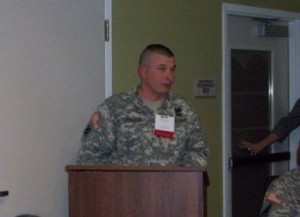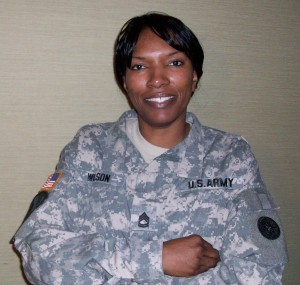By Emily Oehler, WTC Stratcom
Every time I talk with Gina Hill on the phone, I feel better. When I look at pictures of her kids, I smile. When I hear about her wounded husband’s progress, I am thankful. When I hear that they are receiving a new home in a place that is less disruptive for Allen’s PTSD, I am comforted. When I learned that Gina started a non-profit to help build stronger community connections between emergency responders, servicemembers, and local support programs, I am amazed. Knowing this combat-wounded Family makes we want to be a better person and do more!

AW2 spouse Gina Hill starts non-profit, Silent Siren, to build support community for Soldiers, Veterans, and Families facing PTSD. Photo Courtesy of Mike Parker
Allen Hill was serving in Iraq in 2007 when his truck was hit by an improvised explosive device (IED). At the 2010 AW2 Symposium press conference, Gina said, “While the majority of Allen’s physical, or visible, wounds have healed, our Family still struggles daily with the psychological wounds. Often times, these are called the invisible wounds, but I have a hard time calling them that, for they are very visible to anyone who spends any amount of time with him.”
Like most Army Families, the Hills never give up.
The Hills worked at the AW2 Symposium (link) to help the Army identify areas of improvement for warrior care—and provide recommendations. Gina Hill presented to Congress for Mental Illness Awareness Month to increase awareness of the impact of PTSD on the entire Family. And now, they are launching Silent Siren, already a member of the Community Support Network.
The mission of Silent Siren is to build strong community collaborations that enhance and expand existing community crisis intervention/supports for military service individuals and their Families. They believe that the following actions and approaches will help achieve this mission:
• Empower persons supporting an individual with PTSD to utilize local emergency support services
• Educate emergency support personnel and military Families and caregivers about PTSD and the fundamental approaches to responding to PTSD crisis situations.
• Engage local community counseling & support resources that can be readily available to navigate Family members and caregivers through crisis situations.
Silent Siren consists of 3 core elements:
1. Establishment of a PTSD registry for community members with PTSD and market the registry to each participating community.
2. Utilization of Silent Siren to help train emergency services personnel on effective emergency response approaches when responding to PTSD crisis intervention calls.
3. Implement, with the assistance of Silent Siren, a Family/caregiver support system. This system should include professional mental health resources available to respond alongside and emergency responder to help a Family navigate the complexities of a mental health/PTSD crisis situation.
You can get to know the Hill Family a bit tonight, Friday, November 4, on Extreme Home Makeover. Knowing them will show you firsthand how dynamic our Soldiers, Veterans, and Families are—to heed the call to serve in a time of war, and continue to give back once wounded.








